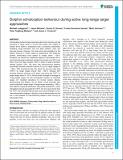Files in this item
Dolphin echolocation behaviour during active long-range target approaches
Item metadata
| dc.contributor.author | Ladegaard, Michael | |
| dc.contributor.author | Mulsow, Jason | |
| dc.contributor.author | Houser, Dorian S. | |
| dc.contributor.author | Jensen, Frants Havmand | |
| dc.contributor.author | Johnson, Mark | |
| dc.contributor.author | Madsen, Peter Teglberg | |
| dc.contributor.author | Finneran, James J. | |
| dc.date.accessioned | 2020-01-25T00:34:57Z | |
| dc.date.available | 2020-01-25T00:34:57Z | |
| dc.date.issued | 2019-01-25 | |
| dc.identifier | 257966858 | |
| dc.identifier | 9e15b632-bb8f-4379-8e51-2c0d2da9645d | |
| dc.identifier | 85060543398 | |
| dc.identifier | 30478155 | |
| dc.identifier | 000457426400011 | |
| dc.identifier.citation | Ladegaard , M , Mulsow , J , Houser , D S , Jensen , F H , Johnson , M , Madsen , P T & Finneran , J J 2019 , ' Dolphin echolocation behaviour during active long-range target approaches ' , Journal of Experimental Biology , vol. 222 , jeb189217 . https://doi.org/10.1242/jeb.189217 | en |
| dc.identifier.issn | 0022-0949 | |
| dc.identifier.uri | https://hdl.handle.net/10023/19353 | |
| dc.description | Financial support was provided by the US Office of Naval Research Code 32 (Mine Countermeasures, Acoustics Phenomenology & Modeling Group). M.L. and P.T.M. were funded by frame grants from the National Danish Research Council (Det Frie Forskningsråd) and by a Semper Ardens grant from the Carlsberg Foundation. M.L.’s travel expenses were covered by grants from Augustinus Fonden and DAS-Fonden (Danish Acoustical Society, Dansk Akustisk Selskab). F.H.J. was funded by an AIAS-COFUND fellowship from Aarhus Institute of Advanced Studies under the EU's Seventh Framework Programme (Agreement No. 609033). | en |
| dc.description.abstract | Echolocating toothed whales generally adjust click intensity and rate according to target range to ensure that echoes from targets of interest arrive before a subsequent click is produced, presumably facilitating range estimation from the delay between clicks and returning echoes. However, this click-echo-click paradigm for the dolphin biosonar is mostly based on experiments with stationary animals echolocating fixed targets at ranges below ∼120 m. Therefore, we trained two bottlenose dolphins instrumented with a sound recording tag to approach a target from ranges up to 400 m and either touch the target (subject TRO) or detect a target orientation change (subject SAY). We show that free-swimming dolphins dynamically increase interclick interval (ICI) out to target ranges of ∼100 m. TRO consistently kept ICIs above the two-way travel time (TWTT) for target ranges shorter than ∼100 m, whereas SAY switched between clicking at ICIs above and below the TWTT for target ranges down to ∼25 m. Source levels changed on average by 17log10(target range), but with considerable variation for individual slopes (4.1 standard deviations for by-trial random effects), demonstrating that dolphins do not adopt a fixed automatic gain control matched to target range. At target ranges exceeding ∼100 m, both dolphins frequently switched to click packet production in which interpacket intervals exceeded the TWTT, but ICIs were shorter than the TWTT. We conclude that the click-echo-click paradigm is not a fixed echolocation strategy in dolphins, and we demonstrate the first use of click packets for free-swimming dolphins when solving an echolocation task. | |
| dc.format.extent | 12 | |
| dc.format.extent | 1837212 | |
| dc.language.iso | eng | |
| dc.relation.ispartof | Journal of Experimental Biology | en |
| dc.subject | Biosonar | en |
| dc.subject | Click packet | en |
| dc.subject | Dtag | en |
| dc.subject | Interclick interval | en |
| dc.subject | Source level | en |
| dc.subject | Toothed whale | en |
| dc.subject | QH301 Biology | en |
| dc.subject | Ecology, Evolution, Behavior and Systematics | en |
| dc.subject | Physiology | en |
| dc.subject | Aquatic Science | en |
| dc.subject | Animal Science and Zoology | en |
| dc.subject | Molecular Biology | en |
| dc.subject | Insect Science | en |
| dc.subject | NDAS | en |
| dc.subject.lcc | QH301 | en |
| dc.title | Dolphin echolocation behaviour during active long-range target approaches | en |
| dc.type | Journal article | en |
| dc.contributor.institution | University of St Andrews. Scottish Oceans Institute | en |
| dc.contributor.institution | University of St Andrews. Bioacoustics group | en |
| dc.contributor.institution | University of St Andrews. Sound Tags Group | en |
| dc.contributor.institution | University of St Andrews. Sea Mammal Research Unit | en |
| dc.contributor.institution | University of St Andrews. Marine Alliance for Science & Technology Scotland | en |
| dc.contributor.institution | University of St Andrews. School of Biology | en |
| dc.identifier.doi | https://doi.org/10.1242/jeb.189217 | |
| dc.description.status | Peer reviewed | en |
| dc.date.embargoedUntil | 2020-01-25 | |
| dc.identifier.url | http://jeb.biologists.org/lookup/doi/10.1242/jeb.189217.supplemental | en |
This item appears in the following Collection(s)
Items in the St Andrews Research Repository are protected by copyright, with all rights reserved, unless otherwise indicated.

